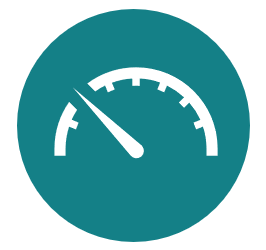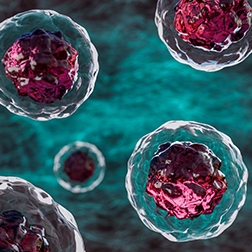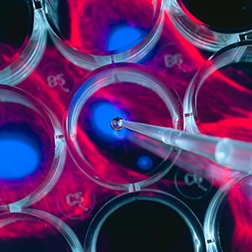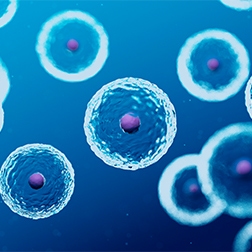
Your edit. Our expertise.
Working with you, we can support your research with our stellar custom cell line development and cell engineering services, providing support for complex projects where your in-house team may lack the expertise, time or resources.
Our specialized cell line engineering services are backed by an extensive portfolio of gene-editing licences and expertise across hundreds of cell lines to achieve the right edited cell line solution. We have broad capabilities, powered by Revvity´s Dharmacon™ reagents, with a specific focus on complex edits and challenging cell types.
Below are just some of the options, however we can partner with you on your complex and challenging projects. Please contact us and we will be happy to discuss your custom project needs.
Our standard deliverables include:
- Up to 2 clones with sequence verification
- Parental cell line
- Functional verification for Cas9 stable and reporter cell line projects
- Mycoplasma testing
- Sterility testing
- Full IP coverage for R&D under Revvity’s CRISPR licenses
- Summary project report
Services include:
- Multigene targeting knockouts
- Large knock-ins
- iPSC editing
- Primary T-cell editing
- Polyploid cancer line editing
- Over-expression knock-ins

STEP 1
Project design
Our experts review your project requirements and provide consultation before onboarding. Choose from our catalogue of parental cell lines or provide your own including iPSCs, primary T-cells, and polyploidy cell lines.

STEP 2
Project engineering
We optimize reagents and transfection protocols, then use automation and machine learning for single-cell dilution. Clones are screened with sequencing so that optimal clones are banked and delivered.

STEP 3
Project delivered
Project updates are provided at regular intervals with validation and QC performed throughout and prior to shipping the final clone and parental line alongside the full data pack.
Learn about our services

Knock-ins and base editing strategies
Complex modifications scalable through automation
Wherever you stand on the intersection of scale and complexity, we can help you move your research forward quickly. We open new possibilities via knock-in projects and the Pin-point™ base editing platform.
Complex modifications scalable through automation
Wherever you stand on the intersection of scale and complexity, we can help you move your research forward quickly. We open new possibilities via knock-in projects and the Pin-point™ base editing platform.
Knock-ins
- Point mutation: Single Nucleotide Polymorphism (SNP)
- Tag / Reporter knock-in
- Fluorescent tags
- His, Myc, or FLAG
- Nano-Glo® HiBiT (Promega), LgBiT (Promega)
- Defined N- or C-terminal insert location
- Inducible expression systems
- Translocation
- Landing pad
- Small targeted genomic changes between 1bp and ≤66bp
- Gene overexpression
- Large genomic insertions of up to ~10kb (random integration)
- Large knock-in: Large genomic insertions of up to ~10kb (targeted locus)
- Activation (CRISPRa) or silencing (CRISPRi) of gene of interest at endogenous locus
| Knock-in strategy | Main uses | Key advantages |
|---|---|---|
| Single-stranded oligodeoxynucleotide (ssODN) donors | Small targeted genomic changes between 1bp and 66bp |
High KI efficiencies increased chance of homozygous clone recovery (2 - 3N) Shorter project timelines |
| Scarless editing with ssODN donors | Only mutation of interest introduced | |
| Pin-point base editing platform | Single base, predictable genomic changes |
High KI efficiencies increased chance of homozygous clone recovery (>3N) Multiplex editing |
| Plasmid donors | Large genomic insertions (targeted or random integration) of up to ~ 10kb | Can introduce a large variety of large cargo into a precise genomic location |
| Lentivirus | Activation (CRISPRa) or silencing (CRISPRi) of gene of interest at endogenous locus |
Not reliant on gRNA availability Shorter project timelines |
| Gene overexpression | Different levels of gene expression possible |
Related content

Knockouts
Generate the right modification in the right background
Save time and resources while you focus on other work with more than 200 parental cell lines from around 20 tissue types or provide your own cell line for onboarding to our conditions.
Generate the right modification in the right background
Save time and resources while you focus on other work with more than 200 parental cell lines from around 20 tissue types or provide your own cell line for onboarding to our conditions.
Knockouts
- Single knockout
- Double knockout
- Small defined deletion
- Large genomic deletion
Customers can choose from one of our in-house cell lines or provide a cell line to onboard. During the onboarding process, we perform mycoplasma and sterility testing, as well as assess transfectability and single-cell dilution growth characteristics, where applicable.
In parallel with the cell line assessment phase, we also design and evaluate the reagents to be used in the manufacturing process.
During the cell line engineering phase, our team performs the desired edit(s) defined in the statement of work. Throughout the process, our Project Management team provides regular updates and will contact you promptly if any issue or complication should arise during the manufacturing process.
After manufacturing is complete, the cell line is validated for the desired edit. We validate at the genomic level with Sanger sequencing as standard and for our reporter cell lines we provide a functional readout that verifies reporter expression.
Related content

iPSCs
Tackling disease with iPSCs and genome editing
Our custom cell line engineering services are an efficient platform to edit complex pluripotent stem cells for disease modelling to support a variety of genetic variations.
Tackling disease with iPSCs and genome editing
Our custom cell line engineering services are an efficient platform to edit complex pluripotent stem cells for disease modelling to support a variety of genetic variations.
At Revvity, we have successfully generated over 50 genotypes, achieving differentiation into all three germ layers. Our projects span a range of genetic modifications, including homozygous and heterozygous SNPs, reporter insertions, and gene knockouts.
iPSC cell editing:
- Single knockout
- Point mutation (SNP) knock-in
- Tag / Reporter knock-in
- Large knock-in
Our iPSC engineering projects can be designed in stages:
- Step 1: iPSC generation, provided by the customer
- Step 2: Characterization
- Step 3: Gene Engineering, including
- Point Mutations
- Gene Knock-out
- Reporter alleles
- Step 4: Verification (as optional):
- Pluripotency
- Marker expression
- Karyotyping
Related content

Functional assay add-ons
Expand your engineered cell model with industry-leading screening projects. Use your custom cell line to power functional genomics or cell panel screening assays.
Or, with the cell line engineering teach, achieve even more with the ability to tailor our services with a full suite of add-ons.
Expand your engineered cell model with industry-leading screening projects. Use your custom cell line to power functional genomics or cell panel screening assays.
Or, with the cell line engineering teach, achieve even more with the ability to tailor our services with a full suite of add-ons.
- Delivery of additional clones,
- Delivery of the edited pool for standard knockout projects
- qRT-PCR for cDNA cassette knock-ins
- Nano-Glo® HiBiT (Promega) and NanoLuc® (Promega) tag assessment
- High content imaging for reporter validation
- Flow cytometry readouts
- Supernatant protein analytics with HTRF™, AlphaLISA™ and BioLegend™ LEGENDPlex™ technologies

Licensing
Revvity has agreements in place with several licensors to work with an extensive catalogue of cell line backgrounds. Additionally, we may be able to support clients in accessing further cell lines.
Revvity has agreements in place with several licensors to work with an extensive catalogue of cell line backgrounds. Additionally, we may be able to support clients in accessing further cell lines.
Knock-ins
*Products that have utilized CRISPR Cas9 systems and methodologies to knock-in a gene, and their use, may be the subject of one or more of the following patents and applications controlled by Sigma-Aldrich Co. LLC (SIGMA): Patent applications and issued patents that entered their respective National Stage from PCT International Pub. No. WO 2014/089290, including, but not limited to, the following, and substitutions, divisions, continuations, continuations-in-part, reissues, re-examinations, and extensions thereof: Australia Patent Nos. 2013355214; 2017204031; and 2018229489; Canada Patent Nos. 2,891,347 and 2,977,152; China Patent No. CN105142669; European Patent Nos. EP 2 928 496 B1; EP 3 138 910 B1, 3 138 911 B1, EP 3 138 912 B1, EP 3 360 964 B1, EP 3 363 902 B1; Israel Patent No. IL238856; Singapore Patent No. 11201503824S; South Korea Patent Nos. 10-1844123 and 10-2006880; and U.S. Patent Nos. 10,731,181 and 10,745,716; and U.S. Application Serial Nos. 15/188,927; 15/188,931; and 15/456,204 (the “Patent Rights”).
iPSC editing
Certain drug screening, target validation and toxicity testing methods that utilize in-vitro differentiated disease models may be covered by one or more patents controlled by Evotec International GmbH. Those patents include EP2270196B1, EP1745144B1 and EP3070174B1 and corresponding foreign patents and pending applications. The purchase or transfer of this product is not intended, either expressly or by implication, to grant any right or license to practice under the foregoing patents. Purchasers are advised to contact Evotec International GmbH at info@evotec.com for information regarding a license to practice under such patents.
*Note on inducible cell line projects: Revvity uses the Tet-On 3G inducible expression system for inducible custom engineering projects. This platform is based on the Tet-On® 3G bipartite induction system: a tightly regulated system consisting of an optimized inducible RNA polymerase II promoter (TRE3G), which provides both minimal basal expression and potent activation upon induction with doxycycline. Prior to starting an inducible cell line engineering project, it is the responsibility of the client to provide licensing from Clontech Laboratories for freedom to use this system.
Terms & conditions
All cell line engineering projects are subject to our Terms & Conditions and our Limited Use Label License.































